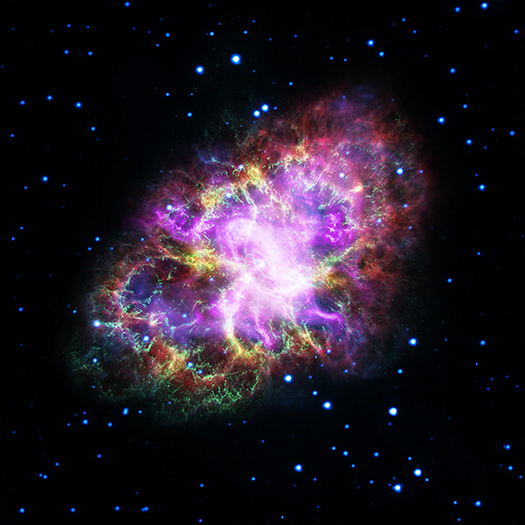Observatories Combine to Crack Open the Crab Nebula

The Crab Nebula
Astronomers have produced a highly detailed image of the Crab Nebula, by combining data from telescopes spanning nearly the entire breadth of the electromagnetic spectrum, from radio waves seen by the Karl G. Jansky Very Large Array (VLA) to the powerful X-ray glow as seen by the orbiting Chandra X-ray Observatory. And, in between, the Hubble Space Telescope's crisp visible-light view and the infrared perspective of the Spitzer Space Telescope.
The Crab Nebula, the result of a bright supernova explosion seen by Chinese and other astronomers in the year 1054, is 6,500 light-years from Earth. At its center is a super-dense neutron star, rotating once every 33 milliseconds, shooting out rotating lighthouse-like beams of radio waves and light — a pulsar. The nebula's intricate shape is caused by a complex interplay of the pulsar, a fast-moving wind of particles coming from the pulsar, and material originally ejected by the supernova explosion and by the star itself before the explosion.
This image combines data from five different telescopes: The VLA (radio) in red; Spitzer Space Telescope (infrared) in yellow; Hubble Space Telescope (visible) in green; XMM-Newton (ultraviolet) in blue; and Chandra X-ray Observatory (X-ray) in purple.
The new VLA, Hubble, and Chandra observations were largely made at about the same time in November 2012. Chandra has been observing the Crab Nebula since shortly after the telescope was launched into space in 1999 and has repeatedly done so in the years since. X-ray data reveal the structure and behavior of the high-energy particles being spewed from the pulsar at the center of the Crab, which provides important clues to the workings of this mighty cosmic generator producing energy at the rate of 1,000 suns.
A paper describing the latest multi-wavelength work on the Crab, led by Gloria Dubner (IAFE), appears in The Astrophysical Journal and is available online. NASA's Marshall Space Flight Center in Huntsville, Alabama, manages the Chandra program for NASA's Science Mission Directorate in Washington. The Smithsonian Astrophysical Observatory in Cambridge, Massachusetts, controls Chandra's science and flight operations.
